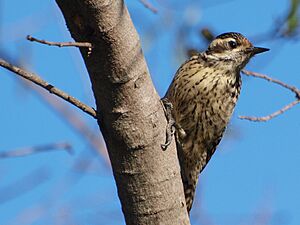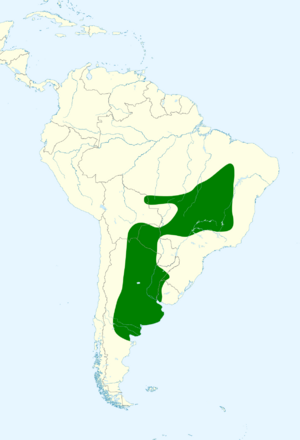Checkered woodpecker facts for kids
Quick facts for kids Checkered woodpecker |
|
|---|---|
 |
|
| Female in Buenos Aires, Argentina | |
| Conservation status | |
| Scientific classification | |
| Genus: |
Veniliornis
|
| Species: |
mixtus
|
 |
|
| Synonyms | |
|
|
The checkered woodpecker (Veniliornis mixtus) is a type of bird that belongs to the woodpecker family. You can find this bird in several South American countries, including Argentina, Bolivia, Brazil, Paraguay, and Uruguay.
Contents
About the Checkered Woodpecker
What's in a Name?
The checkered woodpecker got its scientific name, Picus mixtus, from a Dutch scientist named Pieter Boddaert in 1783. The name Veniliornis comes from a Roman goddess, Venilia, and the Greek word for "bird." The word mixtus is Latin for "mixed" or "jumbled," which might refer to its patterned feathers.
Scientists sometimes change how they group animals as they learn more. This woodpecker was once placed in different groups, but now most experts agree it belongs in the Veniliornis group.
Different Types of Checkered Woodpeckers
There are four main types, or subspecies, of the checkered woodpecker:
- V. m. cancellatus
- V. m. mixtus (this is the original type)
- V. m. malleator
- V. m. berlepschi
These subspecies look a bit different from each other and live in slightly different areas.
What Does It Look Like?
The checkered woodpecker is a small bird, about 14 centimeters (5.5 inches) long. It weighs about 30 to 37 grams (1 to 1.3 ounces), which is about the same as a few pieces of candy!
Both male and female checkered woodpeckers have blackish-brown and white feathers. Their upper parts are blackish-brown with white or brownish-white stripes. Their tails are brownish-black with thin white stripes. Their undersides are white with dark brown streaks.
Males vs. Females
You can tell the difference between male and female checkered woodpeckers by looking at their heads.
- Males have some white or light streaks on their crown (the top of their head) and a red or orange-red patch on the back of their neck.
- Females have a solid black crown and no red on their neck.
Young woodpeckers look a bit duller than adults. Both young males and females have some red on their crown, but the female's red patch is smaller.
Subspecies Differences
The different subspecies have slight variations in their colors. For example, V. m. berlepschi is a bit darker brown, and V. m. cancellatus is much browner overall with wider white stripes on its upper parts.
Where Does It Live?
The checkered woodpecker lives in various parts of South America.
- V. m. cancellatus lives in eastern Bolivia and parts of Brazil.
- V. m. mixtus is found in eastern Argentina, southeastern Brazil, and western Uruguay.
- V. m. malleator lives in the Chaco Basin, which includes parts of Bolivia, Paraguay, and northern Argentina.
- V. m. berlepschi is found in central and eastern Argentina.
These woodpeckers like to live in open woodlands and forests, especially those near rivers. You can also find them in savannas and other bushy areas. They usually live from sea level up to about 600 meters (2,000 feet) high.
How Does It Behave?
Moving Around
Scientists don't know much about how checkered woodpecker populations move. Some have been seen in certain parts of Brazil only during specific months, but more research is needed to understand their travel habits.
What Does It Eat?
Checkered woodpeckers usually look for food alone or in pairs. They mostly search on small branches of bushes and trees. Their diet includes insects and seeds, which they find by pecking and probing into the bark.
Building a Nest
The breeding season for checkered woodpeckers is from September to November. Both the male and female work together to dig a nest hole. They usually make their nests about 3 to 6 meters (10 to 20 feet) off the ground in a tree or a palm. A female woodpecker typically lays four eggs. We don't know how long the eggs take to hatch or how long the young birds stay in the nest.
Sounds It Makes
The checkered woodpecker makes a "peek" sound and a "we-we-we..." sound. For talking to other woodpeckers far away, it makes a long trilling sound like "ti-ti-ti-ti-ti..." It also drums on trees, just like other woodpeckers!
Is It Endangered?
The IUCN (International Union for Conservation of Nature) has listed the checkered woodpecker as a species of "Least Concern." This means that it is not currently considered to be in danger of extinction. It lives across a very large area, and even though we don't know the exact number of birds, their population seems to be stable. There are no immediate threats to this species, and it lives in several protected areas.
Images for kids




